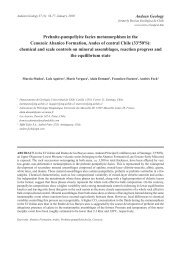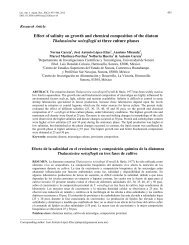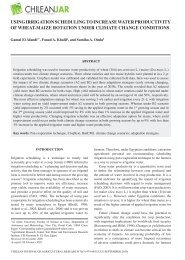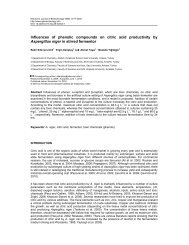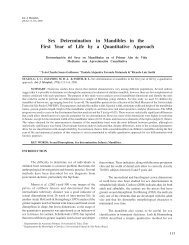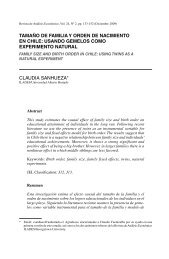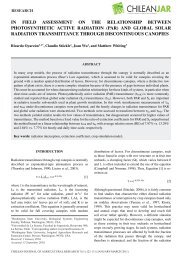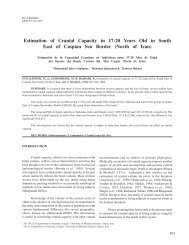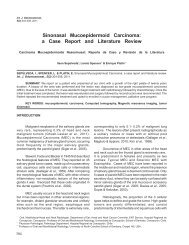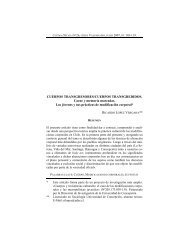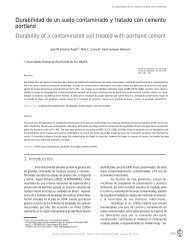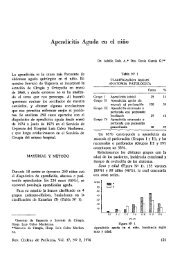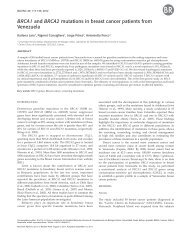Familial benign chronic pemphigus (Hailey-Hailey Disease ... - SciELO
Familial benign chronic pemphigus (Hailey-Hailey Disease ... - SciELO
Familial benign chronic pemphigus (Hailey-Hailey Disease ... - SciELO
You also want an ePaper? Increase the reach of your titles
YUMPU automatically turns print PDFs into web optimized ePapers that Google loves.
CASOS CLíNiCOS<br />
as in inverse psoriasis and in different forms of<br />
<strong>pemphigus</strong> vegetans.<br />
during the last years, the genetic cause and molecular<br />
pathogenesis of hailey-hailey disease have<br />
been elucidated. The distribution of intracellular<br />
Ca 2+ plays an important role in the regulation of<br />
cell-cell interactions in the epidermis 3 . damage<br />
of desmosomes gives rise to acantholysis, the<br />
characteristic finding in hailey-hailey disease. it<br />
is considered that the increase in cytosolic calcium,<br />
as well as its reduction in the Golgi apparatus leads<br />
to reduced glycosylation and incorrect arrangement<br />
of the intercellular adhesion molecules, i.e. of<br />
the desmosomal proteins 2 . The exact cause of the<br />
mutation of the ATP 2 C 1 gene, which is responsible<br />
for the metabolic disorders at both cellular and sub<br />
cellular levels, remains unclear 8,9 .<br />
The disclosure of the pathogenic mechanisms<br />
in hailey-hailey disease, as well as the creation<br />
of new medications shall probably lead to better<br />
therapeutic effect. The therapies that are usually<br />
applied, like topical corticosteroids, antibiotics,<br />
both topical and oral antimycotics, and isotretinoin<br />
are not always a successful treatment option.<br />
Chronic treatment with corticosteroids may lead<br />
to skin atrophy, telangiectasia, striae distensae and,<br />
possibly, to increased vulnerability to infections in<br />
the affected areas 2 . Calcineurin inhibitors (cyclosporin<br />
A, tacrolimus and pimecrolimus), initially<br />
introduced for post-transplant immunosupression,<br />
proved also useful for some inflammatory<br />
skin diseases, namely atopic eczema 2 .<br />
during last years, tacrolimus and pimecrolimus<br />
were studied and showed a very favorable<br />
clinical effect both in short and long duration<br />
treatments in patients with atopic dermatitis and,<br />
consequently, these molecules gained recognition<br />
as good topical immunomodulators 2,11 . The topical<br />
application of both preparations is not associated<br />
with any of the undesirable side effects arising after<br />
oral treatment with cyclosporin A. Pimecrolimus<br />
penetrates less through the skin and this leads, at<br />
least theoretically, to less risk of systemic effects<br />
compared to tacrolimus 2 . Pimecrolimus shows<br />
a higher affinity to epithelial structures, but its<br />
affinity to lymphoid structures is lower compared<br />
to tacrolimus 2 .<br />
Tacrolimus, pimecrolimus and cyclosporin A<br />
block calcineurin in the cytoplasm and lead to<br />
suppression of T-cell function. Tacrolimus and<br />
pimecrolimus achieve these effects through the<br />
636<br />
<strong>Familial</strong> <strong>benign</strong> <strong>chronic</strong> <strong>pemphigus</strong>. Report of one case - G. Tchernev et al<br />
initial linkage to the cytosolic receptor fKbP-12,<br />
designated also as macrophillin-12 2,10 . in contrast<br />
to them, cyclosporin A binds to another cytosolic<br />
receptor from the macrophillin group, the<br />
cyclophillin 2 . The macrophillin-12 – Cl complex<br />
blocks the calcineurin phosphatase and this<br />
leads to activation (through dephosphorylation)<br />
of NfAT (nuclear factor of activated T-cells).<br />
This blocks the transportation of NfAT to the<br />
nucleus, inhibiting the synthesis of immunomodulatory<br />
cytokines: il-2, il-4, il-8, TNf-α and<br />
γ-interferon. Consequently, there is impairment<br />
in the proliferation of T-cells that participate and<br />
maintain the inflammatory process. Pimecrolimus<br />
also blocks the expression of the receptors that<br />
take part in the processes of differentiation of the<br />
T-cell population 2,12 .<br />
An important advantage of both medications<br />
is that they do not block the synthesis of collagen<br />
in skin fibroblasts and do not lead to atrophy, in<br />
contrast to topical corticosteroids. The immunosuppressive<br />
effect of pimecrolimus is weaker than<br />
that of tacrolimus 2 .<br />
This allowed also the application of a modern<br />
pathogenic approach leading to a quick control<br />
of clinical skin abnormalitie without inducing<br />
the side effects usually associated with corticosteroids<br />
11,12 . A successful treatment of patients<br />
suffering from hailey-hailey disease applying tacrolimus<br />
has been described in the literature 12 , and<br />
this makes us provide this information about the<br />
favorable local treatment held with pimecrolimus.<br />
in untreated skin lesions of hailey-hailey disease,<br />
a significant infiltration with T-lymphocytes<br />
has been demonstrated in previous works, considerably<br />
decreasing after the therapy not only<br />
with tacrolimus and pimecrolimus, but also with<br />
cyclosporin-A 2 .<br />
The cause of T-cell infiltration in hailey-hailey<br />
disease is not clear yet. The fast beneficial impact<br />
of immune regulators on skin symptoms suggests,<br />
however, that T-lymphocytes play some role in the<br />
pathogenesis of the disease.<br />
The specific effect of tacrolimus and pimecrolimus,<br />
blocking the pathologic T-cellular response<br />
shows that in the pathogenesis of hailey-hailey<br />
disease, additionally to the genetic defect, a dysregulation<br />
of the cellular immune response is also<br />
present. Suppression of the proliferation of T-cells<br />
by pimecrolimus quickly controls the acantholysis<br />
in this disease 2 .<br />
Rev Med Chile 2011; 139: 633-637




